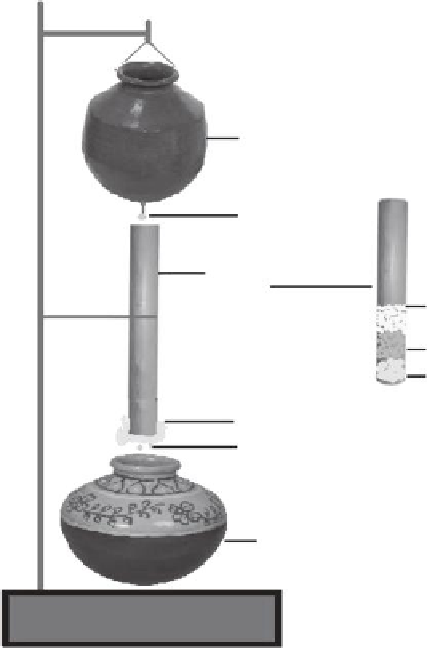Environmental Engineering Reference
In-Depth Information
Water
reservoir
Water
droplet
Bamboo
column
Adsorbent
Sand
Coir
Piece of cloth
Water
droplets
Treated
water
FIGURE 17.9
Schematic of bamboo-column-based technique for domestic rural water deluoridation.
17.7.8 Recent Developments in Materials for Defluoridation
Adsorption-based deluoridation processes still dominate water treatment. There have
been several reports on the development of improved adsorbents in recent years. Ben et
al. (2011) evaluated the cuttleish bone as an adsorbent material (available in Tunisia) for
the deluoridation of water. The results show effective sorption of luoride on cuttleish
bone even when natural/ield water was tested. The eficacy for removal of luoride from
water was found to be about 80% at pH 7.2, 1 h contact time, 15 g/L adsorbent dose, and
5 mg/L initial luoride concentration. Despite the different anions generally present in
natural waters, a luoride concentration in agreement with the norm (<1.5 mg/L) could be
achieved in a variety of natural water samples examined.
Zhang et al. (2012) reported on a new adsorbent zirconium-modiied Na-attapulgite
(Zr-A), synthesized by a facile method. The Zr-A adsorbent exhibited good adsorption for
luoride over a wide pH range. One of the interesting observations was its high adsorption
capacity even after six reuse cycles.
Mohapatra et al. (2012) prepared a high-surface-area nanopowder of Mg-doped ferrihy-
drite. The results showed 0.98% Mg-doped ferrihydrite to be an effective luoride adsorbent
giving a maximum adsorption capacity of as much as 64 mg/g. The kinetics data itted
well to a pseudo-second-order kinetic model. The isothermal data followed a Langmuir
model. Thermodynamic parameters conirmed the adsorption process to be spontaneous

